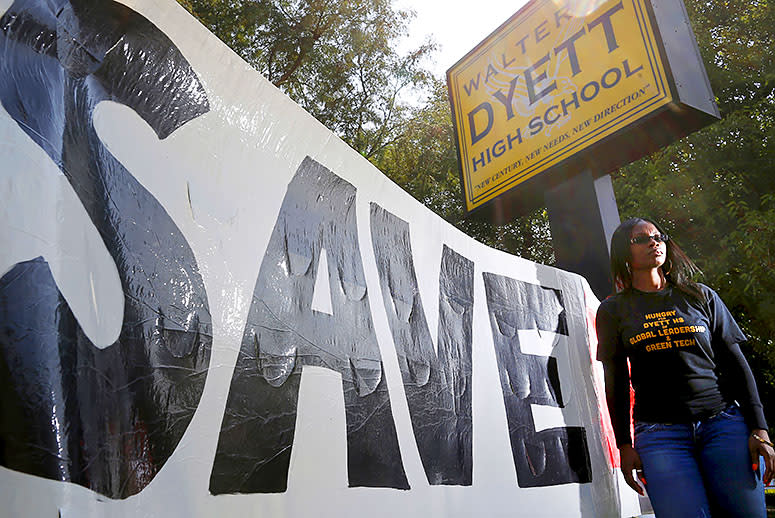Seattle Teachers’ Strike A Win For Social Justice

Seattle Teachers’ Strike A Win For Social Justice
By Jeff Bryant
“Striking teachers in Seattle appear to have been victorious in getting most of their demands met … Their demands for increased pay was just one item in a much more extensive list of demands that demonstrate how badly fans of education reform misrepresent and misunderstand what teachers unions often fight for.”
Read more …
Read more …
NEWS AND VIEWS
School Districts See Teacher Shortages After Years Of Cuts
Associated Press
“After years of recession-related layoffs and hiring freezes, school systems in pockets across the United States are in urgent need of more qualified teachers. Shortages have surfaced in big cities such as Tampa, Florida, and Las Vegas … as well as in states such as Georgia, Indiana, and North Dakota … California … will need 21,000 new teachers annually over the next 5 years … School administrators and academic researchers point to a variety of reasons for the shortages … Nationwide, the number of students training to be teachers has declined from 719,081 in 2010 to 499,800 in 2014 … Even districts that were able to meet their needs this year are bracing for a projected shortage.”
Read more …
Read more …
The Number Of Black Teachers Has Dropped In Nine U.S. Cities
The Washington Post
“The number of black public school teachers in 9 cities … dropped between 2002 and 2012 … In Boston, New York, Los Angeles, Chicago, Cleveland, New Orleans, Philadelphia, San Francisco, and Washington, D.C. … The issue of teacher diversity is important because research has suggested that students who are racially paired with teachers – black teachers working with black students and Hispanic teachers working with Hispanic students – do better academically … Researchers examined the decade between 2002 and 2012 because it was a period of rapid expansion of public charter schools and closures of traditional district schools. There also were other state and federal policy changes, such as the use of teacher evaluation systems, that caused some churn and upheaval in teaching ranks.”
Read more …
Read more …
After 25 Years, Teach For America Results Are Consistently Underwhelming
Nonprofit Quarterly
In an op ed Patricia Schaefer writes, “TFA has total assets of close to half a billion dollars and revenues of more than $330 million, of which about 90% comes from government grants and contributions … While TFA teachers in early primary grades produced roughly 1.3 months of extra reading gains … an overwhelming majority of TFA staff (87%) reported that they did not plan to spend the rest of their career as a classroom teacher or, for that matter, in any education-related career … Even in those limited cases in which TFA shows a positive impact, it is consistently small, and other reform efforts, such universal pre-K, teacher mentoring programs, and smaller class sizes, may have more promise over the long run. The sticking point that returns again and again is that of teacher attrition … There is remarkably little testimony available from veteran teachers, guidance counselors, parents, and other school stakeholders about TFA’s ultimate impact on whole school environments.”
Read more …
Read more …
When “School Choice” Leads Families To Trade One Bad School For Another
The Hechinger Report
“In Chicago, researchers … found that many families did pull their children out of failing schools. But they usually ended up in ones that were just as bad, or only slightly better … Given the choice of commuting a long way to a high-performing school on the other side of town and transferring to a school in the neighborhood, low-income parents tend to choose the latter … The choices closer to home are often little, if at all, better than poor students’ current schools … This NYU study largely conforms with earlier research, finding that public school choice doesn’t suddenly improve schools for low-income students.”
Read more …
Read more …
Putting More Technology In Schools May Not Make Kids Smarter: OECD Report
The Huffington Post
” While school districts around the globe have invested immensely in technological resources over the past few years – 72 percent of students in OECD countries now use computers at school – this development isn’t necessarily having a positive impact on student learning … Students who use computers moderately at school tend to do somewhat better than students who use computers rarely and significantly better than students who use computers frequently … Increased exposure to technology in school does not mean that disadvantaged students are catching up to their affluent peers in terms of digital skills. To close these gaps, low-income students will have to be provided with better schools overall … Schools should invest more in training teachers on digital tools, while maintaining a healthy skepticism about computer programs they use in the classroom.”
Read more …
Read more …


















